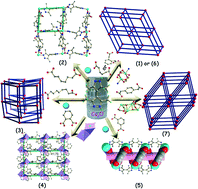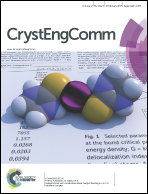Synthesis, structural versatility and magnetic properties of a series of copper(ii) coordination polymers based on bipyrazole and various dicarboxylate ligands†
Abstract
Seven new copper(II) coordination networks combining flexible 3,3′,5,5′-tetramethyl-4,4′-bipyrazole (bpz) and diverse dicarboxylates, [Cu(bpz)0.5(adip)]n (1), [Cu2(bpz)4(sub)2]n (2), [Cu4(bpz)1.5(aze)·H2O]n (3), [Cu2(bpz)(pta)2(H2O)·H2O]n (4), [Cu2(bpz)(ipa)]n (5), [Cu2(bpz)(o-pda)2·H2O]n (6), and [Cu2(μ3-OH)(bpz)(p-pda)1.5·H2O]n (7) (H2adip = adipic acid, H2sub = suberic acid, H2aze = azelaic acid, H2pta = phthalic acid, H2ipa = isophthalic acid, H2o-pda = o-phenylenediacetic acid, H2p-pda = p-phenylenediacetic acid), have been obtained under solvothermal conditions and structurally verified by single-crystal X-ray diffraction analyses and further characterized by elemental analyses, powder X-ray diffraction (PXRD), infrared spectroscopy (IR), UV-vis spectroscopy and thermogravimetric analyses (TGA). Single crystal X-ray diffraction analysis revealed that both 1 and 6 are 6-connected pcu networks (point symbol: {412·63}) based on paddle-wheel [Cu2(COO)4] secondary building units (SBU). Complexes 2 and 4 are 2D 44-sql networks based on a single metal ion node and a binuclear [Cu2(COO)4(H2O)] SBU, respectively, while complex 3 features an extremely rare 3D 5-connected hxg-d-5-C2/c (point symbol: {42·67·8}) network. Complex 5 shows a 1D tape structure built from bpz sealed 1D helical Cu2(ipa) chains along the b axis, and 7 is a 3D 8-connected hex (point symbol: {36·418·53·6}) network based on a centrosymmetric [Cu4(μ3-OH)2(COO)4] SBU. A thorough structural comparison of these coordination networks suggests that the coordination fashions, conformations of dicarboxylates along with the different inorganic Cu(II) SBUs simultaneously play a significant role in constructing the diverse networks. Variable-temperature magnetic susceptibility data denote that 4 and 7 display antiferromagnetic interactions in binuclear [Cu2(COO)4(H2O)] and [Cu4(μ3-OH)2(COO)4] SBUs. Moreover, the thermal stability and UV-vis spectra of 1–7 are discussed in detail.



 Please wait while we load your content...
Please wait while we load your content...